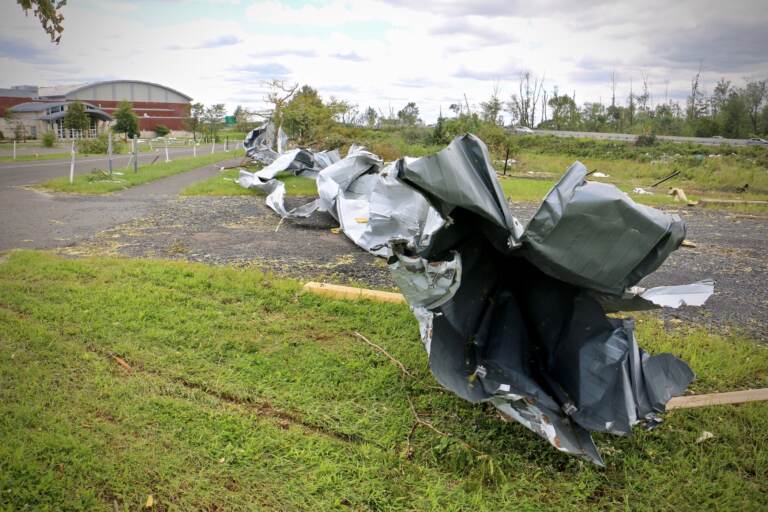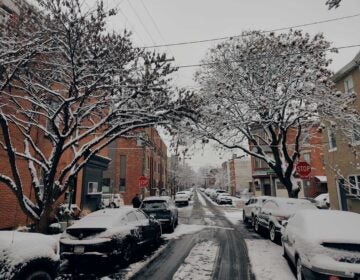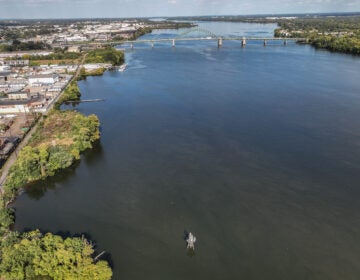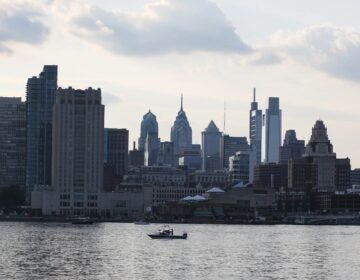The science behind the Delaware Valley’s tornado summer
The remnants of Hurricane Ida generated seven tornadoes in the Delaware Valley. Why is this happening? As long as the “ingredients” are present, they can happen anywhere.

A large piece of the Upper Dublin High School roof lies twisted around a tree after a powerful tornado blew through the township. (Emma Lee/WHYY)
Hurricane Ida’s leftovers sent seven tornadoes ripping through the Delaware Valley, bringing the summer’s tornado total up to 17 across the region. If it feels like a historic (wind) shift is happening, that’s because it is, according to the latest research on the extreme weather events.
In 2018, a team of researchers did a deep dive into the United States’ regional tornado trends and frequencies and found that the Northeast U.S. is increasingly seeing twisters once much rarer in the region.
“What we found is that, even though places like Texas and Oklahoma and Kansas do get the most tornadoes every year, they’re happening with less frequency than they were 40 years ago. And places further to the east, especially around the Mississippi River Valley, the Southeast, the Northeast, and the Midwest are all experiencing increases in their trends through time,” said Victor Gensini, a professor of meteorology at Northern Illinois University who led the research.
Historically, the Delaware Valley isn’t known for tornadoes. The region is about 1,000 miles away from the Central Plains area known as Tornado Alley that’s long been associated with the gale-force winds. But that doesn’t mean Tornado Alley isn’t a threat to the greater Philadelphia region — it’s just risky in a different way.
“It’s sort of a dangerous term, it’s sort of a loaded term. Because I think when a person hears the word ‘alley,’ they probably immediately think of a bowling alley, which sort of defines it as there’s lanes where these tornadoes happen. And we know that that’s not true,” Gensini said.
As long as the ingredients are present, tornadoes can happen just about anywhere, he said. The term “Tornado Alley” gives people in the region a false sense of security, when there shouldn’t be one.
The increasing tornado rates for this part of the country are a red flag, Gensini and others say.
They are unsure exactly why this shift is happening, but for some, it fits the “mold” of climate change. According to Gensini, there are climate models that predict a decrease in tornadoes across the Great Plains and an increase in tornadoes farther east.
“Except, the only caveat is that a lot of the models don’t have this happening until after 2050,” Gensini said.
Tying climate change to individual weather events can be complicated. Climate scientists believe there is a better way to link the two.
While climate and weather are related, they aren’t the same, but that doesn’t mean that climate change didn’t make an event like this one even worse.
Sean Sublette is a meteorologist at Climate Central in Princeton, and he says tropical systems already produce a lot of rain. Climate change can multiply that.
“I always caution when we have an event like this, that people say ,‘This has never happened before.’ Sure, it’s happened before. But not very much, very rare. That this type of thing will not be as rare as it has been in the past,” Sublette said.
Climate change may not cause what were previously 100-year rain storms to happen every summer, Sublette said.
But every 10 to 15 years? That could now be a possibility.
Though it is generally easier to find climate change’s massive influence in torrential rain and even excessive heat, that’s not the case for tornadoes.
As an assistant professor of geography and the environment at Villanova University, Stephen Strader has seen the Delaware Valley’s unusual weather patterns of late.
Though he thinks people should be careful making direct links between tornadoes and climate change, at this point, Strader said, there is another important topic that needs to be discussed.
“These are the things that we’ve predicted [with] climate change, and we’re starting to see unfold, but what I don’t want to get lost in the discussion is our underlying societal changes as well,” Strader said.
Both Strader and Gensini cautioned against the idea of just focusing on the hazards that climate change is creating — that’s only half the problem, they said. Gensini said he fields calls all the time from people seeking his expertise, and answers as these extreme weather events become more frequent.
He often follows up with a question of his own:
“My major question is, what is your city, what is your town, what is your county — what is your local government doing to prevent the next big climate disaster in your area?”
He usually gets crickets, he said. A year passes, and the cycle continues. In addition to focusing on climate change, Gensini and Strader think human infrastructure needs to be completely reevaluated.
Repeating the same mistakes, such as removing green space and creating more impervious surfaces, will only lead to the same disastrous consequences — like parts of the Vine Street Expressway being completely underwater.
“The narrative here should be that it’s not just climate change. It’s also our societal landscape,” Strader said. “A good example is you don’t want to have years of neglect in a system, and then keep ignoring it. Eventually, you’re going to have to fix it. And I think our infrastructure is right there now, where we’re going to pay for it one way or the other. And it’s a bit scary to think about.”

Get daily updates from WHYY News!
WHYY is your source for fact-based, in-depth journalism and information. As a nonprofit organization, we rely on financial support from readers like you. Please give today.







